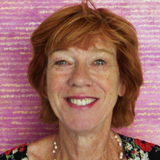Since 1997, Wil van Blokland has lived and worked in the classrooms of the former Lourdes convent school on Jisperweg. The entire building has been renovated into a beautiful place where the Beemster light and the silence inspire contemplative images. Strength, simplicity and colour, sometimes subdued but at other times exuberant, are characteristic of the work Van Blokland, who over the pas 25 years has created an impressive oeuvre. Still, at times she has the inspiring feeling that she has only just begun.
Her early work is characterized by soberness, yet placed in a confrontation between materials like stone and glass versus weak clay. In the recent series No Conept she consciously made images that do not evoke associations, challenging people to look with an open, free mind. The experience is what counts for her. Her work is not figurative, yet Wil van Blokland’s ceramic pieces are about people, relationships and feelings.
Periods of making pieces are alternated with projects such as Inner Smiles, smiles from all over the world, captured in porcelain by Van Blokland. Closer to home she conceived several art projects for and by residents of Amsterdam Geuzenveld, Slotervaart and now Bloemenbuurt in Purmerend. People bring along their own personal material, which she converts with them into colourful installations in which the residents recognize themselves.
Wil van Blokland is particularly noted for the 170 monuments she made and the innovation they represent. In Purmerend, thanks to her, a monument was finally erected on the children’s mound where unbaptized children used to be buried anonymously. An abstract ceramic sculpture with glass, entitled ‘In God’s hand’, offers consolation to relatives. On the public cemetery in Purmerend stands the Golden Spiral as a symbol of the road everyone must travel from birth to death.
This exploration in the visual arts is informed by a study of anthropology on the one hand and the teacher training course d’Witte Lelie on the other. The freedom that was allowed her there, combined with the thorough follow-up study she did at the Amsterdam School of the Arts, laid the foundation of her skills, which were strengthened by work periods in the United States and Japan, as well as travels to Mali, Mongolia, Sulawesi and Peru. There, a passion for the unfamiliar and curiosity came together.
If you are open enough, you might just catch a glimp of a universal visual language.
Marjolein Tummers, 2009
